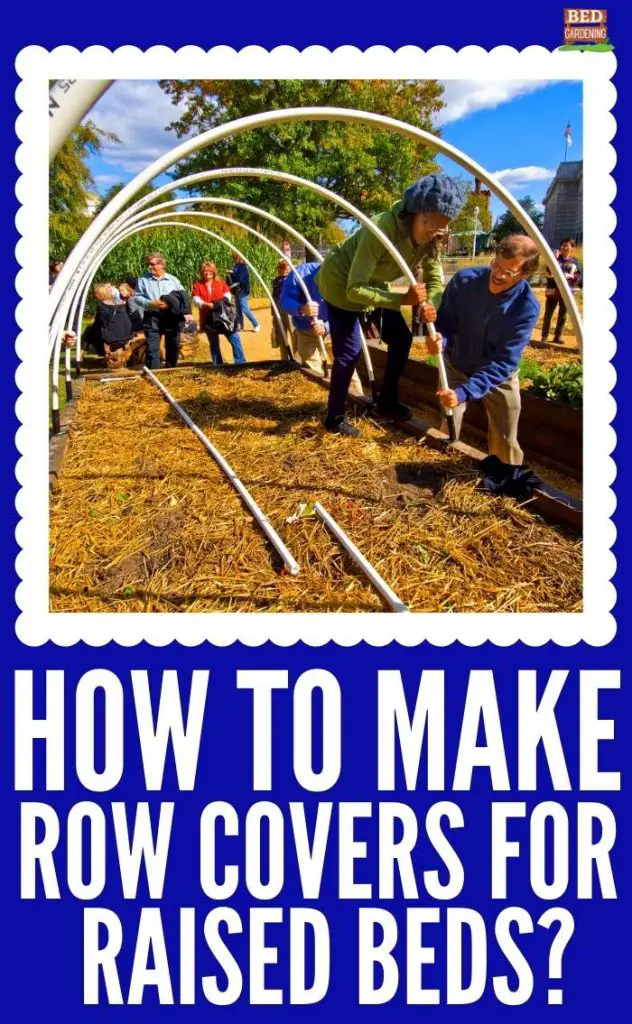Protecting plants from the onset of winter is a big issue. Row cover is best for protecting your plants in frost for this purpose. But the question is, what is a row cover?
“A covered support structure positioned over your raised beds protects plants from frost, snow, and extreme temperature as well as keeping pests away”.
This is a versatile technology that can be used to achieve a number of desirable outcomes. This is a small hoop house style structure that can support whatever frost covering material you need and can be mounted to the bed in a couple of ways.
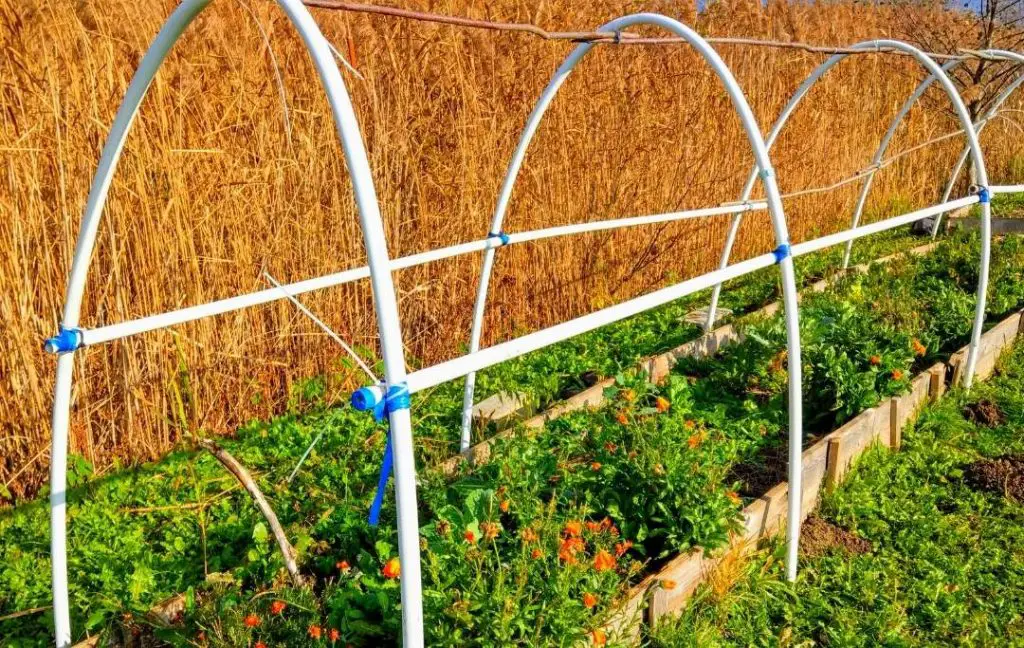
A simple way to do this is to suspend protective cloth or plastic material above the plants to cover them but not to touch them. It is best to build a support structure to increase airflow, allow for plenty of room to grow, and avoid any damage that may be caused to the plants by unsupported fabric beating in the wind.
Use fabric that allows plenty of light through. It is a simple way to make your gardening easy. After researching, you can find a variety of designs of cold frames, cloches, hoop houses, and floating row covers for this objective.
In this article, we will discuss how to cover a raised garden bed. It’s not too hard to do, little hard work is needed for this act but your plants will be secure for the whole winter season.
Read More: How To Improve The Soil In My Raised Beds?
Benefits of Covering Raised Beds
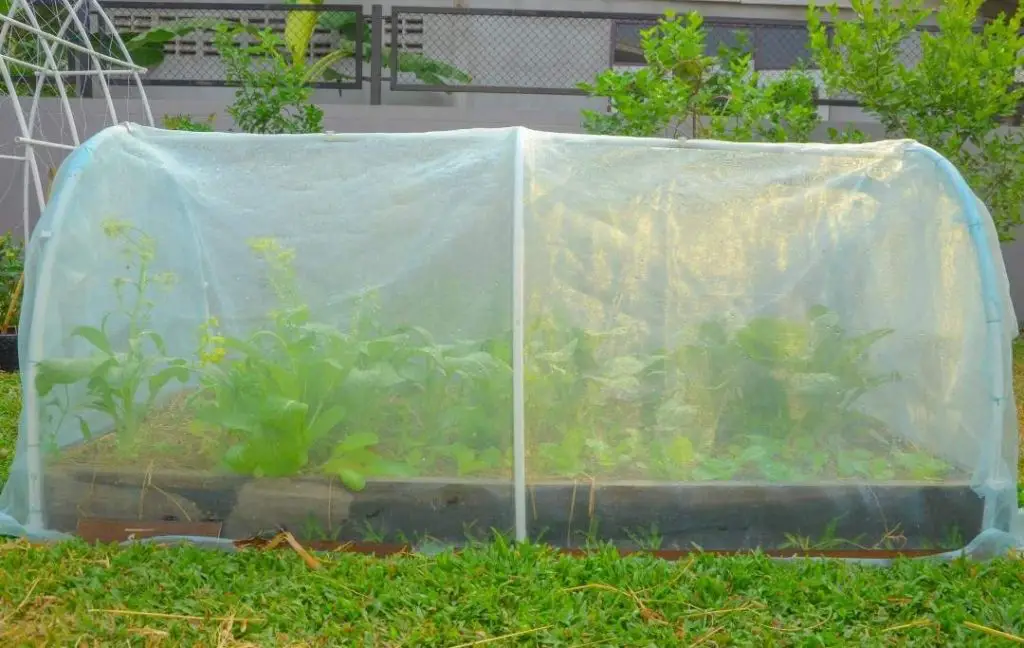
The danger of frost or freeze is very obvious in the winter season. You have to think about your defense system for your plants before starting the winter, so for this purpose, you have to cover your raised beds. There are many benefits of covering raised beds. The reasons for covering your bad are as follows
- One of the most important benefits is that your plants get good air circulation.
- 6 hours of Sunlight is available.
- It keeps your plants safe from hale, wind, and other threats.
- Poly films can trap heat when temperatures start to rise.
- All these coverings will keep out flying and hopping insects. You can use a bird netting to prevent your plants from birds.
- You can use chicken wire or hardware cloth to prevent your raised bed from animals like rabbits, dogs, cats, raccoons, and squirrels.
- If you are living in a hot covering, then sun exposure is a danger for your plants. You can use covering to prevent your crops with shade cloth to reduce light up to 90%.
- You can extend your growing season by using a good raised cover.
- You can easily reuse it for the next fall season. If you maintain it properly and stored when not in use row cover can last for many years before needing replacement. Polythene plastic will last for a maximum of three to five years before becoming too foggy. In the same way, the polyester fabric will also last three to five years before becoming too worn to be effective. But it depends on your product quality, climate, and usage frequency.
- Plastic is very good to prevent your soil from winter rains. The soil surface will warm more quickly and its nutrients will not be lost. Plastic prevents rains from causing soil compaction and erosion as well.
- Row covers are very good because they allow water, air, and light to pass through to your plants.
- Row covers are very inexpensive, economical, easy to use and an essential tool for your non-stop garden. If you calculate the total cost of row cover versus the value of crops you grow under them is more.
- You can improve your seed germination in direct-sown crops.
Read More: How to Fill Your Tall Raised Beds?
Materials You Need to Make Row Covers
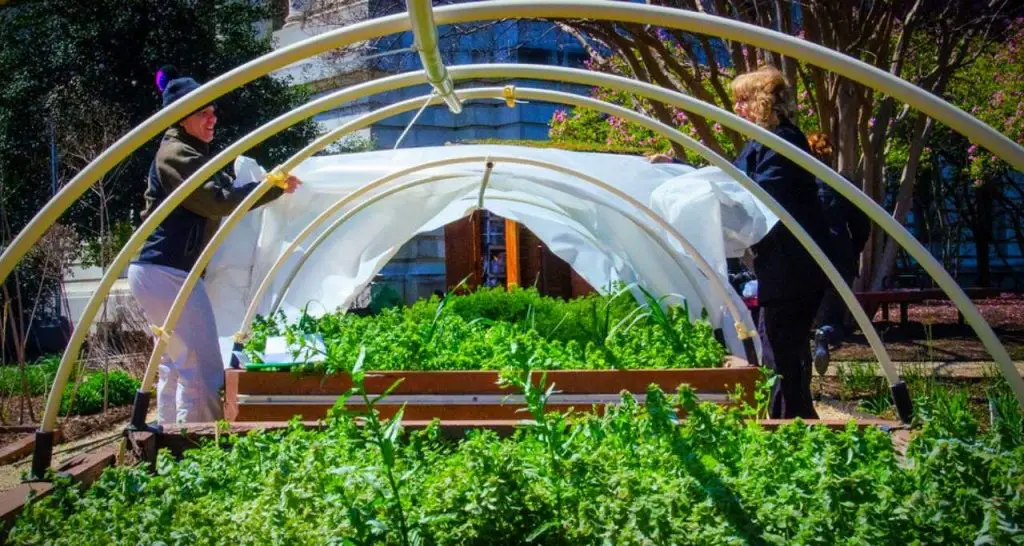
For making row covers you need the following things.
- PEX pipe: This type of plastic pipe is easily available in the plumbing section of most home improvement stores. For this purpose, you need 5 feet of ½ ” diameter PEX for every hoop segment on our 3-foot wide bed. You need one segment for every 3 feet of length for a total of 5 hoops per bed.
- 7/16″ × 48″ round wood dowel: For each hoop segment, you need one dowel (cut in half).
- 3.5 mil plastic sheeting: Now you need something to cover the beds. We are using plastic sheets for this purpose. You should buy the cover according to the length of each bed. You can easily find out the dropcloth from any home improvement store.
- Scissors
- lopping shears
- Tape measure
- Logs, stones, or bricks to secure the plastic.
- Mallet
- Pencil
Read More: Self Watering System for your Raised Beds
Method for Building Hoop
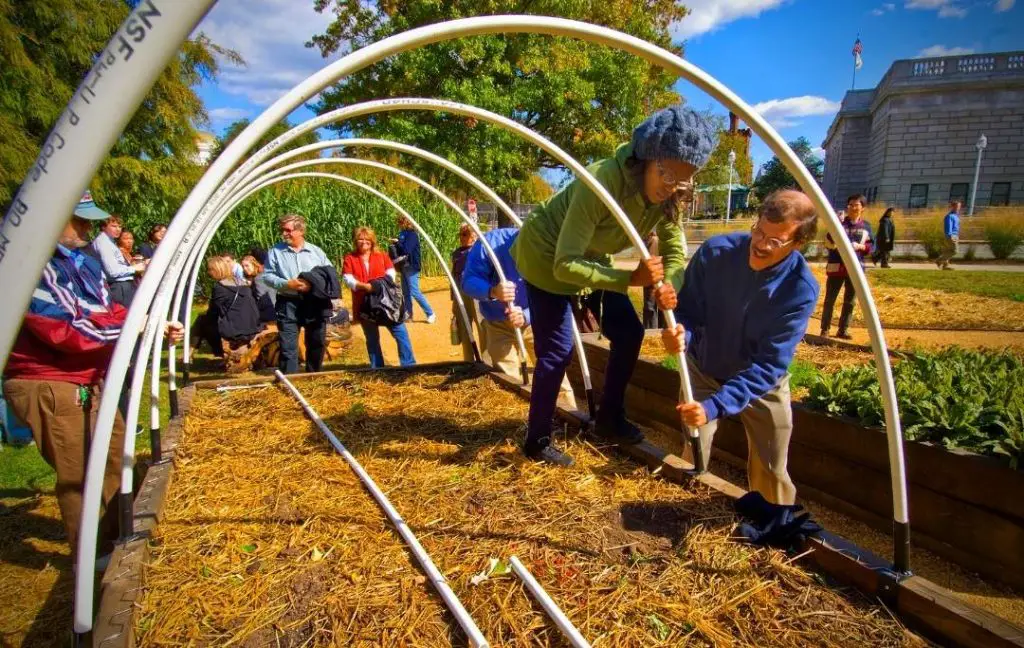
1- Start cutting the dowels to support each side of the hoop. You can make 2-foot segments using a cutting device. It is not necessary to take the exact size, just cut the dowels in the middle.
2- Measure the length of the size of a raised bed for which you are making the cover. If your bed’s length is 3 feet. You should cut a five feet segment of PEX using a cutting device. If the bed is wider than 3 feet adjust this size according to the length. You cannot do this task alone because it needs two persons, so one can hold the PEX to the tape measure while the other marks and cuts. If you succeed in cutting one segment you can use that as a template for the remaining cuts. Cut all the hopes for your raised bed for making the row cover.
3- Now pound in each stake halfway leaving about a foot in the ground and a foot sticking out. You can place stakes on each corner, then place one set in the middle, and another in the middle of each half.
4- This is the most important step. At this point, the raised bed’s freeze protection frame is basically finished. To install the hoops push the PEX piping over the dowels. Side the pipe down several inches. It does not need to be pushed to ground level. You can repeat this process for all hoops. Now, this structure is strong enough to hold up frost clothes, frost blankets, or plastic covering.
5- You can use plastic sheeting for covering the hoop structure. It is very easy to unroll the sheeting alongside the garden bed and cut it once unrolled. When cutting of plastic to the desired length is done, unfold it and drape it over the hoops. Two persons can do this task very easily but you can do it alone also. You can also use a frost blanket instead of plastic sheeting to cover your bed.
6- You can use logs, bricks, rocks, or other objects as weights. Secure the plastic around the hoop.
7- You can easily watch your plants growing under the cover, enjoying a warm and cozy hoop house. Now you can easily grow your vegetables like peppers, lettuce, broccoli, kale, sweet potatoes, and a variety of herbs. Your plants are safe even in the strong wind. Covered beds are an effective way to provide frost and wind protection.
Heavier covers are more reliable and long-lasting and expensive as compared to lightweight covers. Lightweight covers do not provide frost protection but they can protect plants from animals, birds, and pests. It is very good to use a theme in the summer as compared to cold. You can choose a lightweight, medium weight, or heavyweight covers depending on your needs.
Read More: 10 Waist High Raised Garden Beds Plans
Fabric or Plastic Which is Best ?
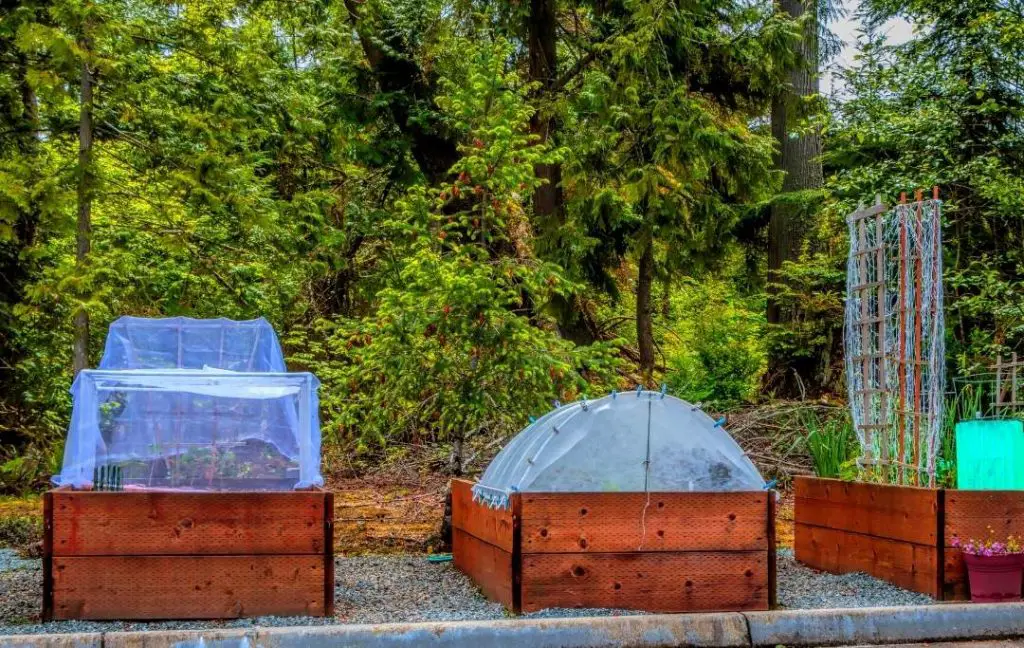
When we decide to make row covers for our beds the first thing comes in our mind, which cover is best for your raised beds, fabric, or plastic. This is a tricky question and it depends on what you are growing, your climate, time limit, and other factors.
Row covers are generally constructed from either polythene plastic or polythene fabric.
If you use polythene plastic then there is airflow between inside and outside, especially on sunny days. Another drawback is that it traps more heat than polyester fabric.
Plastic is better if you are living in a cold climate, as its use will not bake your plants. Fabric does not offer cold protection but allows airflow. It also allows water from rain which is not possible in plastic covers. You have to pull back the plastic on rainy days to provide irrigation to your plants.
Read More: Best Annuals Flowers For Raised Beds
Tips About Use of Row Cover
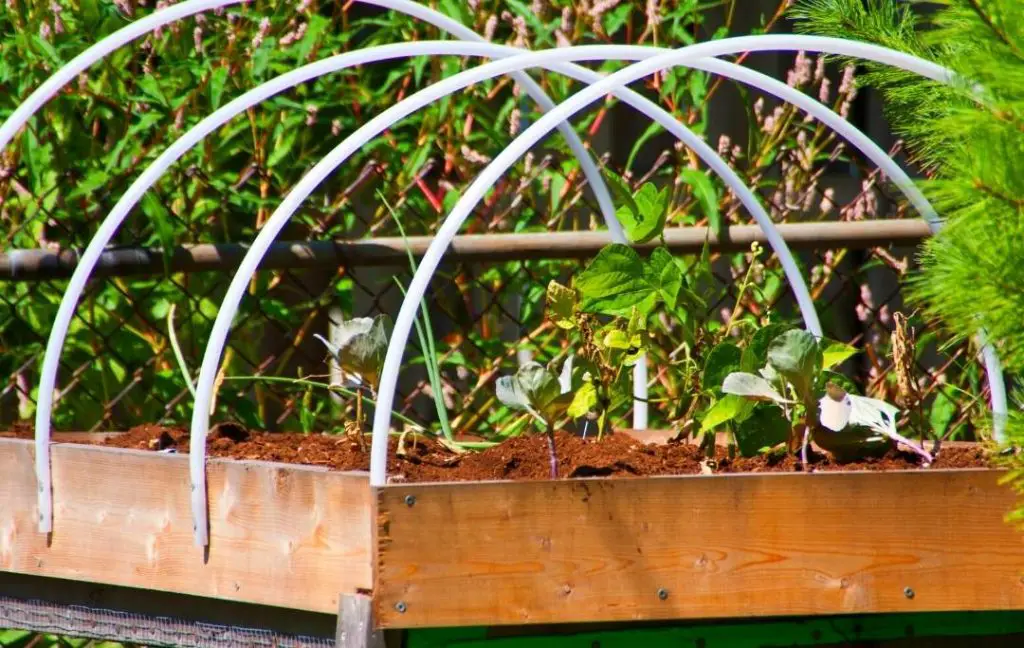
Here are some tips which you have to consider while using the row cover. In this way, you can increase the growth of your plants even in the winter.
- It is very good to secure the edges with heavy objects such as bricks, sandbags, plastic bottles filled with water, or smooth rocks because the row covers will blow off during heavy rain or storm. By taking this precaution you can save them in strong winds.
- Be careful about choosing the covering material for your beds if there is a very warm environment in your raised bed then no one can stop the growth of pests or insects inside it. Because this environment is very suitable for their growth, they can easily multiply themselves and increase their population. To control their growth you have to use any product for organic pests control.
- Row covers block bees and other pollinators, but your plants need insect pollination. The cover must be removed when your plants are blooming. If you don’t want to remove the cover entirely, just open the ends or roll up the sides during the morning, when pollinators are most active.
- Monitor the temperature at day time because the temperature under the row cover is getting too high. In hot weather, you may have to remove the whole cover and put it back on before nightfall.
- Cleanliness is very important for the growth of your plants. If it is possible to wash your row cover, then remove it and wash it.
Row cover is an effective way to protect your crops from birds, pests, frost, storms, and unexpected spring cold snap and it also helps you to retain moisture within your raised bed even in winter. This will improve the yield of your food crops.
